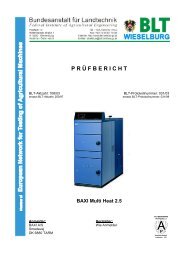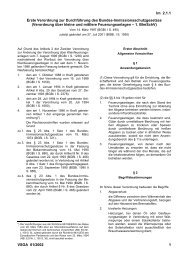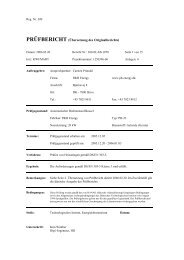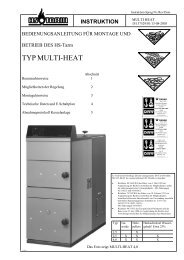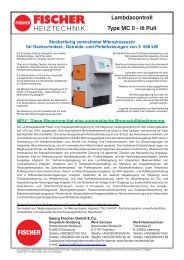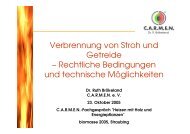Development of 0.5 MWe Scale DeSOX-DeNOX ... - Getreideheizung
Development of 0.5 MWe Scale DeSOX-DeNOX ... - Getreideheizung
Development of 0.5 MWe Scale DeSOX-DeNOX ... - Getreideheizung
Create successful ePaper yourself
Turn your PDF publications into a flip-book with our unique Google optimized e-Paper software.
used on a large or a small scale and can much more easily be retr<strong>of</strong>itted in existing<br />
power plants. In addition, it has a lower capital cost and no x-ray radiation shielding.<br />
Recently, it is recognized that the nonthermal plasma technique, especially a pulsed<br />
streamer corona method in applications <strong>of</strong> removal <strong>of</strong> SO 2 and NO X has several features<br />
such as being dry, good use <strong>of</strong> end products, simultaneous treatment, easy processing<br />
control, and no stack reheat. It is particularly efficient only when the pollutant is present<br />
in very small concentrations.<br />
Electrical corona discharge methods can be implemented in many ways, depending<br />
on the geometry <strong>of</strong> the plasma reactor and the electrical power supply (DC, AC, or<br />
pulsed). The types <strong>of</strong> electrical discharge reactors for the treatment <strong>of</strong> contaminated air<br />
include pulsed corona, ferroelectric bed, dielectric-barrier discharge, and surface<br />
discharge. Since pulsed corona reactors with a wire-to-plate configuration have shown<br />
very promising results and could be retr<strong>of</strong>itted to an existing electrostatic precipitator, it<br />
would be especially attractive.<br />
Generally, streamer corona discharge energized by a pulse voltage generator with a<br />
fast rise time can produce an intensive plasma, which effectively promotes gas-phase<br />
chemical reactions. Therefore, uniform streamer formation is necessary to achieve high<br />
performance in the streamer corona treatment. In the case <strong>of</strong> negative polarity, the<br />
ionization zone is limited to the vicinity <strong>of</strong> the discharge electrode and streamers do not<br />
propagate across the electrode spacing. However, positive streamers can propagate<br />
across the electrode spacing, ionizing the treatment volume to a larger degree and more<br />
uniformly [2]. Previous test results [3] show that the SO 2 removal efficiency is higher<br />
than that <strong>of</strong> negative corona when applied.<br />
Until now, both laboratory and pilot scale tests have been conducted in some<br />
countries [2~7]. Those results have indicated significant technical and economical<br />
advantages <strong>of</strong> the nonthermal plasma process based on the pulsed corona discharges<br />
compared to the electron beam process and other conventional methods. In 1988,<br />
industrial-scale experiments on the use <strong>of</strong> the pulsed streamer corona process for the<br />
simultaneous removal <strong>of</strong> NO X and SO 2 from combustion flue gas have been carried out<br />
by the Italian National Electricity Board (ENEL) at the coal-burning power station in<br />
Marghera, Italy [4]. According to the results, the energy consumption rate was up to 5<br />
% <strong>of</strong> electric power generated by the power plant. The energy consumption required by<br />
the process represents the largest operating cost and the transfer efficiency <strong>of</strong> the<br />
electrical energy from a wall-plug to the plasma in a reactor represents a key factor for<br />
the economical competitiveness <strong>of</strong> the process.<br />
It is indispensable to enhance the chemical reaction efficiency and to reduce the<br />
energy consumption since the total energy consumption in the process depends both on<br />
the chemical efficiency <strong>of</strong> the plasma and the energy conversion efficiency from the<br />
main power source to the corona streamers. From the viewpoint <strong>of</strong> energy saving, for<br />
example, the injection <strong>of</strong> chemical additives should be considered and the energy<br />
efficiency in a pulse generator also could be increased up to 80 %.<br />
II. Experimental Setup<br />
1. Pulsed streamer corona reactor




